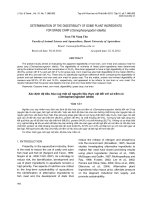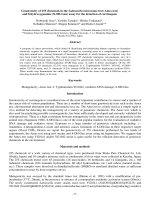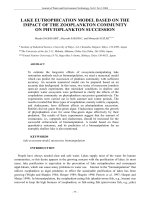The Definition of Biotechnology
Bạn đang xem bản rút gọn của tài liệu. Xem và tải ngay bản đầy đủ của tài liệu tại đây (241.17 KB, 18 trang )
P1: 000
ggbd030c01.tex ggbd030 GR3542/Shmaefsky August 24, 2006 12:16
1
The Definition of
Biotechnology
INTRODUCTION
Biotechnology is the youngest of the sciences and is increasing in knowl-
edge at an unprecedented rate. It is the fastest growing technical disci-
pline and has probably gained more information per year than any other
field of science. Advances in biotechnology even outpace new develop-
ments in computer science. Because of the rapid advance, biotechnol-
ogy is called a revolutionary science that outpaces that ability for people
to keep up with an understanding of applications in society. The term
biotechnology was first used by Hungarian engineer K
´
aroly Ereky in
1919. His use of the term varies somewhat from its meaning today. Ereky
used biotechnology to describe the industrial production of pigs by feed-
ing them sugar beets as an inexpensive large-scale source of nutrients.
He then generalized the term to all areas of industry in which commer-
cial products are created from raw materials with the aid of organisms.
Ereky predicted a biochemical age that rivaled the societal impacts of
the Stone and Iron Ages.
The science of biotechnology is an amalgamation of biology, chem-
istry, computer science, physics, and mathematics. Many scientists who
work in biotechnology fields have a diversity of skills that bring together
two or more science disciplines. Biotechnology is also practiced as a
working relationship between two or more scientists who collaborate
on projects by sharing their expertise and experiences. Certain types
of biotechnology involve many specialized techniques which only a few
people are capable of performing. Yet, other procedures and scientific
instruments used in biotechnology are fairly simple. The biotechnol-
ogy concepts and techniques taught only to graduate and postdoctoral
students in the 1970s are now covered in high school science classes.
P1: 000
ggbd030c01.tex ggbd030 GR3542/Shmaefsky August 24, 2006 12:16
2 Biotechnology 101
Unlike earlier scientific endeavors, biotechnology relies heavily on its
ability to be commercialized into a diversity of procedures and prod-
ucts that benefit humans. More and more scientists who enter biotech-
nology as a career are discovering that they need a strong business
background. A great proportion of biotechnology is being practiced in
industrial settings. Academic biotechnology at most universities is not
carried out solely for the pursuit of information. Many of the new dis-
coveries make their way into consumer and medical products through
a process called technology transfer. Technology transfer is defined as the
process of converting scientific findings from research laboratories into
useful products by the commercial sector. The great potential for profits
that biotechnological innovations can offer has changed the nature of
scientific information over the past 30 years.
Scientific discoveries were once freely shared between scientists by
publishing findings in professional journals. The journals were peer-
reviewed meaning that other scientists familiar with the field evaluated
the accuracy and validity of the information before it was published.
Information in the journals was then made available through profes-
sional scientific societies and through university and industrial libraries.
The advent of computer-to-computer communication systems and the
Internet paved the way for inexpensive means to rapidly disseminate
scientific information. Almost every new finding in biotechnology could
be used to make huge profits for enterprising scientists. This started a
trend in which biotechnology information is not shared freely anymore.
Many scientists argue that this secrecy is stifling the progress of science
and may restrict the growth of science to profit-making endeavors.
Most of the new biotechnology discoveries are patented or are pro-
tected by intellectual property rights. Patenting and intellectual property
rights permit the scientists to protect their discoveries. This protection
prohibits others from using the discoveries or ideas without permission
or some type of payment. A patent is described as a set of exclusive rights
approved by a government to a person for a fixed period of time. The
patent does have a limitation in that the public has the right to know
certain details of the discovery. Patents are only awarded to inventions or
procedures. The person applying for a patent need not be the scientist
who made the discovery. Many scientists who work for biotechnology
companies are required to let the owners of the company patent the
discovery.
An intellectual property right is broader in scope than a patent. It
is the creation of the intellect that has commercial value. Intellectual
property includes any original ideas, business methods, and industrial
P1: 000
ggbd030c01.tex ggbd030 GR3542/Shmaefsky August 24, 2006 12:16
The Definition of Biotechnology 3
processes. Intellectual property rights can be granted for a lifetime. The
international nature of biotechnology has led to the formation of the
World Intellectual Property Organization which is located in Geneva,
Switzerland. Their main goal is “to promote the protection of intellec-
tual property throughout the world through cooperation among States
and, where appropriate, in collaboration with any other international
organization.” A new legal term called biopiracy developed as a result
of protection of biotechnology information. Biopiracy is legally inter-
preted as the unauthorized and uncompensated taking of biological
resources.
Aside from being one of the fastest growing sciences, biotechnology
is also one of the most rapidly growing industries. The U.S. Department
of Labor and the President’s Office of the United States have catego-
rized biotechnology as a high-growth industry. To keep up with the
rapid growth of biotechnology and its impacts on the economy, Presi-
dent George W. Bush in 2003 developed a set of objectives to close the
workforce education gaps in the high-growth industry jobs. His goal was
to have workforce training to provide people with the job skills that are
needed to ensure that the changes in the global economy will not leave
Americans behind. It appears that the growth of biotechnology is too
fast for educators to prepare students with the current knowledge and
skills needed to understand biotechnology and work in biotechnology
careers.
The U.S. Department of Labor recognized the following concerns
related to the growth of biotechnology careers:
r
Biological technician, a key biotechnology occupation, is expected to
grow by 19.4 percent between 2002 and 2012, while the occupation of
biological scientists is projected to grow by 19.0 percent. (U.S. Bureau of
Labor Statistics, National Employment Data)
r
The biotechnology industry employed 713,000 workers in 2002 and is
anticipated to employ 814,900 workers in 2007. (Economy.com, Industry
Workstation, Biotech industry forecast)
r
The population of companies engaged in biotechnology is dynamic and
growth in the biotechnology-related workforce has been vigorous, aver-
aging 12.3 percent annually for those companies that provided data for
2000–2002. Companies with 50–499 employees experienced the fastest
growth, with an annual increase of 17.3 percent, while growth among
larger firms was 6.2 percent. (U.S. Department of Commerce, A Survey
of the Use of Biotechnology in U.S. Industry, Executive Summary for the
Report to Congress)
P1: 000
ggbd030c01.tex ggbd030 GR3542/Shmaefsky August 24, 2006 12:16
4 Biotechnology 101
Other countries are making similar assessments. Biotechnology edu-
cation and training efforts are being implemented in grade schools
and universities throughout Asia, Canada, Europe, and South America.
Public awareness campaigns sponsored by governmental and industrial
organizations are also being put in effect to keep people educated about
biotechnology.
The U.S. Department of Commerce made the following observations
about the global biotechnology market (U.S. Department of Commerce,
Survey of the Use of Biotechnology in U.S. Industry and U.S. Bureau of
Labor Statistics, 2004–05 Career Guide to Industries):
r
Increasingly, companies and research organizations are seeking workers
with more formalized training who have the skills of both computer and
life sciences.
r
For science technician jobs in the pharmaceutical and medicine manu-
facturing industry, most companies prefer to hire graduates from tech-
nical institutes or junior colleges or those who have completed college
courses in chemistry, biology, mathematics, or engineering. Some compa-
nies, however, require science technicians to hold a bachelor’s degree in
a biological or chemical science.
r
Because biotechnology is not one discipline but the interaction of several
disciplines, the best preparation for work in biotechnology is training in
a traditional biological science, such as genetics, molecular biology, bio-
chemistry, virology, or biochemical engineering. Individuals with a scien-
tific background and several years of industrial experience may eventually
advance to managerial positions.
These conclusions are consistent with those of other nations and reflect
the impacts of large technological revolutions throughout history. The
invention of electrical power created a demand for new industries and
updated workforce skills. Moreover, the public had to be persuaded
to adopt electrical power to further fuel the growth of industries that
flourished using electrical power. As recognized by the U.S. Department
of Commerce, biotechnology is a broad field that requires knowledge
of many sciences as well as business principles.
CONTEMPORARY DEFINITIONS OF BIOTECHNOLOGY
Most scientific terms have accurate definitions that are used strictly
by the people who use science in their jobs. However, some terms such
as biodiversity and biotechnology were coined by a person to mean one
thing and then were interpreted to mean other things by many different
P1: 000
ggbd030c01.tex ggbd030 GR3542/Shmaefsky August 24, 2006 12:16
The Definition of Biotechnology 5
people. Some of the definitions of biotechnology are narrower in scope
or only address on a particular type of biotechnology. The following
definitions have been used to describe biotechnology:
“The use of living things to make products.” —American Association for the
Advancement of Science
“Technologies that use living cells and/or biological molecules to solve
problems and make useful products.” —Perlegen Sciences, Inc.
“The application of the study of living things to a myriad of processes, such
as agricultural production, hybrid plant development, environmental re-
search, and much more.” —National Research Council
“Any technological application that uses biological systems, living organ-
isms, or derivatives thereof, to make or modify products or processes for
specific use.” —World Foundation for Environment and Development
“Biotechnology is technology based on biology, especially when used in
agriculture, food science, and medicine.” —United Nations Convention on
Biological Diversity
“The application of molecular and cellular processes to solve problems,
conduct research, and create goods and services.” —U.S. Commerce Depart-
ment
“The industrial application of living organisms and/or biological techniques
developed through basic research. Biotechnology products include phar-
maceutical compounds and research materials.” —Bio Screening Industry
News
“Applied biology directed towards problems in medicine.” —Arius Research,
Inc.
“The application of science and technology to living organisms, as well as
parts, products and models thereof, to alter living or non-living materials
for the production of knowledge, goods and services.” —Organisation for
Economic Co-operation and Development, France
“The ability to reliably manipulate and control living systems, from adding
or subtracting a single gene to cloning an entire organism. This can
be thought of as the manufacturing end of the life sciences industry.”
—University of Michigan, School of Medicine
“Body of methods and techniques that employ as tools the living cells of
organisms or parts or products of those cells such as genes and enzymes.”
—Lexicon Bioencyclopedia
“Biotechnology is the integration of natural sciences and engineering sci-
ences in order to achieve the application of organisms, cells, part thereof
and molecular analogues for products and services.” —University of
Hohenheim, Institute of Food Technology, Denmark
P1: 000
ggbd030c01.tex ggbd030 GR3542/Shmaefsky August 24, 2006 12:16
6 Biotechnology 101
“1. Using living organisms or their products to make or modify a substance.
Techniques include recombinant DNA (see Genetic Engineering) and
hybridoma technology. 2. Industrial application of biological research,
particularly in fields such as recombinant DNA or gene splicing, which
produces synthetic hormones or enzymes by combining genetic material
from different species.” —American Foundation for AIDS Research
“A set of biological techniques developed through basic research and now
applied to research and product development. In particular, the use of
recombinant DNA techniques.” —The Pew Initiative on Food and Biotech-
nology
“The branch of molecular biology that studies the use of microorganisms
to perform specific industrial processes.” —Princeton University WordNet
“The use of current technologies such as DNA technologies for the modifi-
cation and improvement of biological systems.” —Biotech Canada
“Scientific process by which living things (usually plants or animals) are
genetically engineered.” —EcoHealth Organization
“A term designating the use of genetic engineering for practical pur-
poses, notably the production of proteins in living organisms or
some of their components. It is primarily associated with bacteria and
mammalian cells.” —The National Centers of Competence in Research in
Switzerland
CATEGORIES OF BIOTECHNOLOGY
Biotechnology in North America is generally divided into several spe-
cialties such that each has its unique techniques and instrumentation.
Agricultural biotechnology is one of the oldest areas of biotechnology
and involves the production or use of domesticated animals and crops
for food production. Bioenergy biotechnology is another old field of
biotechnology that has been modernized into a strategy for using the
metabolism of organisms to produce electricity or fuel called biofuels.
Bioengineering is the use of artificially derived tissues, organs, or or-
gan components to replace parts of the body that are damaged, lost, or
malfunctioning. Bioethical biotechnology is a field of study that deals
with the ethical and moral implications of biotechnology knowledge and
applications. Bioinformatics is the application of artificial intelligence
systems and supercomputers to handle the collection and analysis of
biotechnology information.
Bionanotechnology uses biological chemicals and cell structures as
the basis for microscopic computers and machines. Consumer biotech-
nology is involved in the use of novel biotechnology discoveries that
can be used as entertainment and in household products. Diagnostic
P1: 000
ggbd030c01.tex ggbd030 GR3542/Shmaefsky August 24, 2006 12:16
The Definition of Biotechnology 7
Agriculture
Energy
Bioremediation
Commercial
Manufacturing
Pharmaceuticals
Figure 1.1 Biotechnology has many applications
in agriculture, energy production, environmen-
tal sciences, manufacturing, and medicine. ( Jeff
Dixon)
biotechnology uses biological
tools to diagnose animal, hu-
man, and plant diseases. Envi-
ronmental biotechnology ap-
plies the metabolism of an-
imals, microorganisms, and
plants as a means of clean-
ing up polluted air, soil,
and water by using a strat-
egy called bioremediation.
Food biotechnology uses the
metabolism of organisms to
assist with the production
and preservation of man-
ufactured foods. Forensic
biotechnology applies various
biotechnology produces and
instruments for resolving the
causes and perpetrators of
criminal activities.
Forest biotechnology in-
vestigates the use of microor-
ganisms, small animals, and
genetically modified plants
for improving the produc-
tion of commercial trees. In-
dustrial biotechnology makes
use of the metabolic reac-
tions of organisms to pro-
duce commercially important
chemicals. Marine biotech-
nology applies the knowledge
and tools of modern biology
and biotechnology to make
use of, study, protect, and
enhance marine and estuar-
ine resources. Mathematical
or computational biotechnol-
ogy develops mathematical
and statistical formulas for interpreting biotechnology findings. Med-
ical biotechnology looks at ways in which biotechnology produces can









